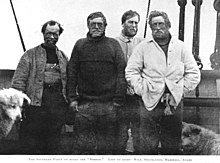Jameson Adams
| Sir Jameson Adams | |
|---|---|

|
|
| Born | 1880 Rippingale, Bourne, Lincolnshire |
| Died | 1962 Westminster, London |
| Allegiance |
|
| Service/branch |
|
| Years of service | 1895-1918 1939-1945 |
| Rank | Captain |
| Battles/wars |
First World War Second World War |
| Awards |
Knight Commander of the Royal Victorian Order Commander of the Order of the British Empire Distinguished Service Order Decoration for Officers of the Royal Naval Reserve Croix de Guerre (France) |
| Other work | Explorer Civil servant |
Captain Sir Jameson Boyd Adams KCVO CBE DSO RD (1880 – 1962) was a British Antarctic explorer and Royal Navy officer. He participated in the Nimrod Expedition, the first expedition led by Ernest Shackleton in an unsuccessful attempt to reach the South Pole.
Born in Rippingale, Lincolnshire, the son of a doctor and the grandson of a captain in the Indian Navy, he ran away from school to enter the merchant navy at the age of 13. In 1902 he became a sub-lieutenant in the Royal Naval Reserve, and on reaching the rank of Lieutenant he was one of the last to gain a Master Mariner's certificate under sail. But he gave up a promising career to join Ernest Shackleton as the second-in-command of the Nimrod Expedition. Despite the expedition's ultimate failure, he was one of the party of four who reached the Polar Plateau for the first time ever, thus showing the way to the Pole. On 9 January 1909 they attained a Furthest South of 88°23′S 162°00′E / 88.383°S 162.000°E, just 97 miles (156 km) from the South Pole, when they were forced by impending starvation to turn back.
On his return from the Antarctic in 1909, he entered the Civil Service, where a year later he was appointed head of the North-Eastern Division of the Employment Exchanges. Recalled to the Navy on the outbreak of the First World War, he became Flag Lieutenant to Admiral Hood commanding the Dover Patrol. Then, after a period of special work at the Ministry of Munitions, he was posted to Flanders to command a battery of naval siege guns. A bad wound in the head necessitated his return in 1917, and he was awarded the Distinguished Service Order and the Croix de Guerre for his services.
...
Wikipedia
